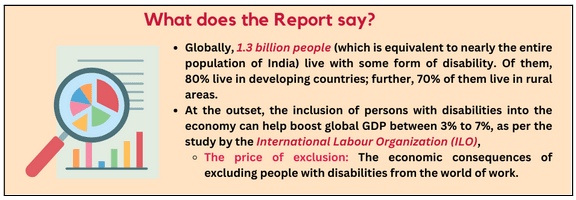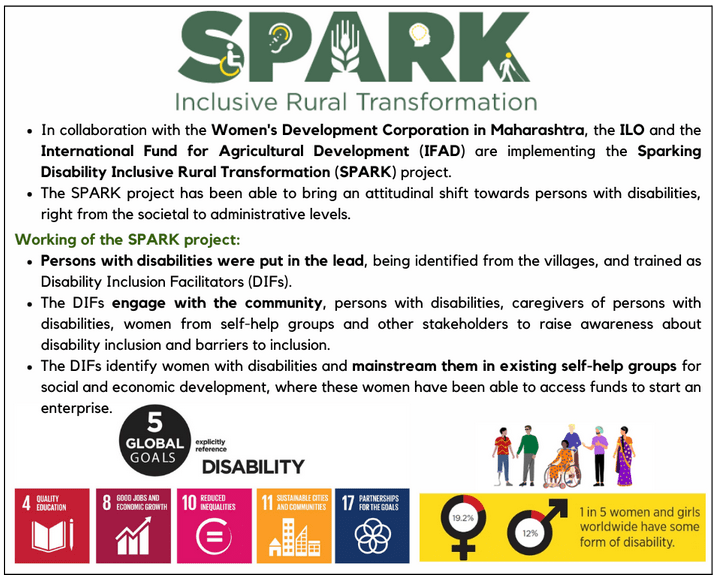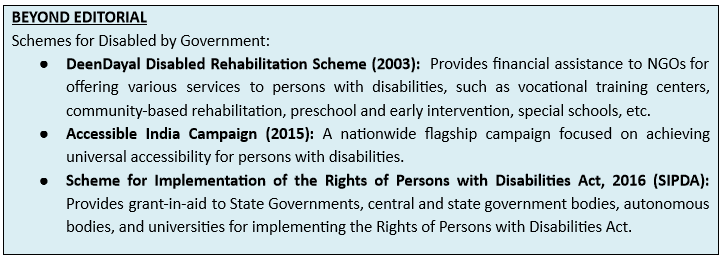India, disability inclusion and the power of ‘by’
"There is no greater disability in society than the inability to see a person as more." - Robert M. Hensel
Relevance: GS I (Social issues)
- Prelims: SPARK project; Rights of Persons with Disabilities Act (2016);
- Mains: Inclusive development; Rights of Persons with Disabilities Act (2016);
Why in the news?
Inclusion of persons with disabilities in all spheres of development, starting with rural areas and rural resilience is necessary to enhance growth and progress.
What is meant by Disability?
Disability is an identity and entity that exists at the intersection of multiple vulnerabilities — social, economic, and gender — with each facet requiring careful consideration when conceptualizing action for equity.

The case for inclusion in India:
- Political Inclusion: India, through Part IV of the Constitution, believes that everyone has the right to equal treatment and opportunities at work, agnostic of any attributes other than the ability to do the job. The reality, however, is mixed.
- Financial inclusion: The current employment scenario is limited, providing fewer jobs for persons with disabilities and perpetuating stereotypes that create further barriers for people with disabilities to access the labor market.
- Disability inclusion is rooted in assuring the rights of persons with disabilities and recognizing the economic benefits of inclusion.
- Social inclusion: It is also in direct contravention of the United Nations Convention on the Rights of Persons with Disabilities, which advocates changing attitudes and perceptions towards persons with disabilities and viewing inclusion from a social development dimension.
What are the issues with the current system?
- Poor infrastructure: Current systems are designed for persons without disabilities and end up being exclusionary to people with disabilities, resulting in them experiencing higher instances of poverty, lack of access to education and opportunities, informality, and other forms of social and economic discrimination.
- Greater challenges in Rural areas
-
- Lack of Awareness: The first step is awareness to ensure last-mile connectivity of the benefits enumerated for people with disabilities by the government, which begins with the capacity-building of community leaders who can advocate for this at the grass-roots level.
- Lack of Infrastructure: Persons with disabilities in rural areas tend to face greater challenges when compared to their urban counterparts, with even more limited access to education and employment. Some developmental schemes, too, exclude them.
- Health: The health sector, particularly in rural India, has not been proactive in addressing disabilities.
- Education: The education system lacks inclusivity, posing a significant challenge in integrating children with mild to moderate disabilities into regular schools.
- Employment: Disabled adults, despite their capability for productive work, face significantly lower employment rates compared to the general population.
- Intersectional Discrimination: They are viewed as objects of charity and not as persons with agency who can participate in decision-making processes.
- Lack of Opportunities: Rural areas have high agricultural dependence and face the heightened risk of climate calamities arising from rising sea levels, reduced access to clean water and food, hurricanes, heat waves, and floods, with rural people at the frontlines of these challenges.
- Rehabilitation Services: There's a significant gap in the availability and accessibility of quality rehabilitation services for persons with disabilities.
- Accessibility: Physical accessibility in buildings, transportation, and access to services remains a major challenge.
Government Initiatives:
- The "Unique ID for Persons with Disabilities” project is being implemented with a view of creating a National Database for PwDs and issuing a Unique Disability Identity Card to each person with disabilities.
- The project will not only encourage transparency, efficiency, and ease of delivering government benefits to the person with disabilities but also ensure uniformity.
- Rights of Persons with Disabilities Act (2016): The Act lays stress on non-discrimination, full and effective participation and inclusion in society, respect for difference, and acceptance of disabilities as part of human diversity and humanity.
- It also promotes equality of opportunity, accessibility, equality between men and women, respect for the evolving capacities of children with disabilities, and respect for the right of children with disabilities to preserve their identities.
- The SPARK project:

Way Forward:
- Need for a sensitized society: According to the English dictionary, “For” is often used when a person is receiving something, and “By” is to “identify the agent acting”. This difference is crucial when it comes to disability inclusion, as the approach is completely different if it is “by” persons with disabilities being a part of the process and not “for” them, without them in the process.
- Need for a Bottom-up approach: A bottom-up approach to disability inclusion is crucial to building productive pathways out of poverty and ensuring that persons with disabilities are recognized as active members of society and the economy.
- Digital India and SDG 9: Building the objective of SDG 9, all digital development projects can be screened to ensure that they are disability sensitive including through the use of universal design and accessibility standards.
- Inputs from the Private Sector: The private sector holds a key in promoting the employment of persons with disabilities.
- In addition to a robust legal framework, experience shows the importance of engaging the private sector and building the confidence of companies to hire and retain workers with disabilities.
Conclusion: The goal of social justice cannot be achieved without the inclusion of persons with disabilities in all spheres of development, starting with rural areas and rural resilience. Although the Engagement of employers’ federations, including those representing small and medium-sized enterprises, as well as with trade unions, has shown to have great potential to promote the employment of persons with disabilities, much needs to be done.

Mains PYQs
Q. Is inclusive growth possible in the market economy? State the significance of financial inclusion in achieving economic growth in India. (2022)
Q. “Investment in infrastructure is essential for more rapid and inclusive economic growth.” Discuss in the light of India’s experience. (2020)

